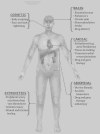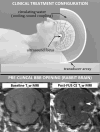Emerging non-cancer applications of therapeutic ultrasound
- PMID: 25792225
- PMCID: PMC4702262
- DOI: 10.3109/02656736.2015.1004375
Emerging non-cancer applications of therapeutic ultrasound
Abstract
Ultrasound therapy has been investigated for over half a century. Ultrasound can act on tissue through a variety of mechanisms, including thermal, shockwave and cavitation mechanisms, and through these can elicit different responses. Ultrasound therapy can provide a non-invasive or minimally invasive treatment option, and ultrasound technology has advanced to the point where devices can be developed to investigate a wide range of applications. This review focuses on non-cancer clinical applications of therapeutic ultrasound, with an emphasis on treatments that have recently reached clinical investigations, and preclinical research programmes that have great potential to impact patient care.
Keywords: Clinical; non-oncologic applications of hyperthermia; ultrasound.
Figures




Similar articles
-
Catheter-based ultrasound technology for image-guided thermal therapy: current technology and applications.Int J Hyperthermia. 2015 Mar;31(2):203-15. doi: 10.3109/02656736.2015.1006269. Epub 2015 Mar 23. Int J Hyperthermia. 2015. PMID: 25799287 Free PMC article. Review.
-
MRI-controlled transurethral ultrasound therapy for localised prostate cancer.Int J Hyperthermia. 2010;26(8):804-21. doi: 10.3109/02656736.2010.503670. Int J Hyperthermia. 2010. PMID: 21043572
-
Therapeutic applications of ultrasound.Prog Biophys Mol Biol. 2007 Jan-Apr;93(1-3):111-29. doi: 10.1016/j.pbiomolbio.2006.07.005. Epub 2006 Aug 4. Prog Biophys Mol Biol. 2007. PMID: 16930682 Review.
-
Feasibility of using interstitial ultrasound for intradiscal thermal therapy: a study in human cadaver lumbar discs.Phys Med Biol. 2005 Jun 21;50(12):2807-21. doi: 10.1088/0031-9155/50/12/006. Epub 2005 May 25. Phys Med Biol. 2005. PMID: 15930604
-
High-intensity focused ultrasound principles, current uses, and potential for the future.Ultrasound Q. 2006 Dec;22(4):263-72. doi: 10.1097/01.ruq.0000237259.25885.72. Ultrasound Q. 2006. PMID: 17146334 Review.
Cited by
-
Remote targeted implantation of sound-sensitive biodegradable multi-cavity microparticles with focused ultrasound.Sci Rep. 2019 Jul 3;9(1):9612. doi: 10.1038/s41598-019-46022-0. Sci Rep. 2019. PMID: 31270380 Free PMC article.
-
Therapeutic Ultrasound as a Treatment Modality for Physiological and Pathological Ageing Including Alzheimer's Disease.Pharmaceutics. 2021 Jul 1;13(7):1002. doi: 10.3390/pharmaceutics13071002. Pharmaceutics. 2021. PMID: 34371696 Free PMC article. Review.
-
Synergistic efficacy of ultrasound, sonosensitizers and chemotherapy: a review.Ther Deliv. 2017 Mar;8(5):331-342. doi: 10.4155/tde-2016-0080. Ther Deliv. 2017. PMID: 28361613 Free PMC article. Review.
References
-
- Watson T. Ultrasound in contemporary physiotherapy practice. Ultrasonics. 2008;48(4):321–329. - PubMed
-
- Heckman JD, Ryaby JP, McCabe J, Frey JJ, Kilcoyne RF. Acceleration of tibial fracture-healing by non-invasive, low-intensity pulsed ultrasound. J Bone Joint Surg Am. 1994;76(1):26–34. - PubMed
-
- Bhojani N, Lingeman JE. Shockwave lithotripsy-new concepts and optimizing treatment parameters. Urol Clin North Am. 2013;40(1):59–66. - PubMed
-
- Fry WJ, Fry FJ. Fundamental neurological research and human neurosurgery using intense ultrasound. IRE Trans Med Electron. 1960;ME-7:166–181. - PubMed
-
- Hynynen K, Jolesz FA. Demonstration of potential noninvasive ultrasound brain therapy through an intact skull. Ultrasound Med Biol. 1998;24(2):275–283. - PubMed
Publication types
MeSH terms
Grants and funding
LinkOut - more resources
Full Text Sources
Other Literature Sources
Medical
